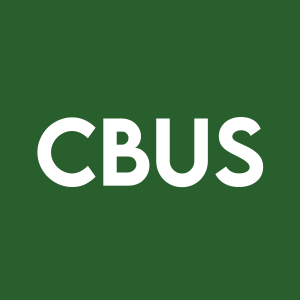Cibus Reports Second Quarter Financial Results and Provides Year-to-Date Business Update for 2025
Rhea-AI Summary
Cibus (NASDAQ:CBUS) reported Q2 2025 financial results and provided significant business updates. The company is streamlining operations to focus on Rice herbicide tolerance traits and partner-funded programs, aiming to reduce annual cash usage to $30 million by 2026.
Key developments include: commercialization of Rice herbicide tolerance traits HT1 and HT3 targeting Latin America launch in 2027 and U.S. expansion in 2028, with potential annual royalties exceeding $200 million; a new collaboration with Colombian Rice producer Semillano; and progress in sustainable ingredients programs expected to generate initial revenues in 2025.
Financial highlights: Q2 net loss of $26.6 million ($0.61 per share), cash position of $36.5 million, and successful completion of a $27.5 million public offering. The company expects current cash to fund operations into Q2 2026.
Positive
- Targeting initial Rice herbicide tolerance traits launch in Latin America (2027) and U.S. (2028) with potential $200M+ annual royalties
- Secured new collaboration agreement with Colombian Rice producer Semillano
- Successfully raised $27.5M in gross proceeds from public offering
- Reduced quarterly net loss to $26.6M from $28.5M year-over-year
- Expecting initial revenues from sustainable ingredients program in 2025
- Received favorable regulatory developments in EU, Ecuador, India, Asia and U.S. markets
- Successfully delivered three germplasm lines with HT3 trait to existing Rice customer
Negative
- Cash runway only extends into Q2 2026
- Continuing operational losses with $26.6M net loss in Q2
- Board evaluating strategic alternatives, indicating potential concerns about standalone viability
- EU regulatory process for New Genomic Techniques failed to reach final agreement by June deadline
Insights
Cibus narrows focus to Rice traits and partner programs, extending runway while progressing toward 2027-2028 commercialization with significant royalty potential.
Cibus is implementing a strategic focus shift that appears well-calculated. The company is streamlining operations to concentrate on Rice herbicide tolerance traits and partner-supported programs, expected to reduce annual cash burn to
The Q2 results show tangible progress in their Rice platform: delivering three germplasm lines with the HT3 trait to an existing customer and signing a collaboration agreement with Colombian Rice producer Semillano. These partnerships demonstrate market validation for their technology in a critical global crop. The company's recent
The regulatory landscape continues to evolve favorably for gene-editing technologies globally. Notable developments include Ecuador determining Cibus' Rice traits are equivalent to conventional breeding (significant for Latin American expansion), USDA-APHIS designating their HT2 canola trait as "not regulated" (their 17th such designation), and the California Rice Commission approving field research - the first authorization for gene-edited Rice in California.
On the financial side, R&D expenses decreased to
The company's progression toward commercialization, particularly for the Rice traits and sustainable ingredients program (expected to generate nominal revenues in 2025 with expansion in 2026), represents a crucial transition from pure R&D to initial revenue generation. The strategic narrowing of focus allows Cibus to concentrate resources on near-term commercial opportunities while maintaining a diverse opportunity pipeline available for partnerships.
Streamlining operational focus on Rice herbicide tolerance traits and partner-funded and/or supported programs, expected to reduce annual cash usage to approximately
Commercialization of Rice herbicide tolerance traits HT1 and HT3 on track – targeting an initial commercial launch in Latin America beginning in 2027 and expanding to the U.S. in 2028, with potential annual accessible royalties of over
Signed a collaboration agreement with the Colombia based Rice seed company Semillano
Completed delivery of three germplasm lines with the Cibus HT3 trait to existing Rice customer
Continue to meet development milestones as we seek commercialization of partner-funded and/or supported sustainable ingredients products; on track for planned nominal revenues in 2025 and targeted commercial expansion in 2026
Global regulatory environment remains supportive of gene editing technologies, with positive year-to-date developments in EU, Ecuador, India, Asia and U.S. markets
Raised
SAN DIEGO, Aug. 14, 2025 (GLOBE NEWSWIRE) -- Cibus, Inc. (Nasdaq: CBUS) (the "Company"), a leading agricultural technology company that develops and licenses plant traits to seed companies, today announced its financial results for the quarter ended June 30, 2025, and provided a year-to-date business update for 2025. Management will host a conference call and webcast today at 4:30 p.m. ET.
Management Commentary
"Our second quarter update demonstrates our continued execution toward initial commercial launch of our priority productivity traits and industrialization of plant breeding technologies," said Peter Beetham, Interim Chief Executive Officer of Cibus. "We remain laser-focused on our core priorities: advancing our Rice herbicide tolerance traits and our partner-funded and/or supported sustainable ingredients program. Our Rice traits are progressing on schedule toward targeted initial launches in Latin America beginning in 2027 and expanding to the United States in 2028, which would generate initial royalty revenue and set the stage for further opportunities in the immense Rice market. Also gaining momentum in the near-term is our partner-funded and/or supported sustainable ingredients program, where our biofragrance products are expected to generate nominal revenues yet this year, with targeted commercial expansion planned in 2026. These focused efforts, combined with our cost streamlining initiatives, the implementation of which is already underway, are expected to reduce our annualized cash usage to approximately
"Our continued progress toward commercialization, our strong pipeline of traits available for partnerships, and the favorable position of global regulations for gene editing technologies create new opportunities for customer engagement and market penetration. In fact, we are excited to announce a new collaboration agreement with the Colombian Rice producer Semillano. We are moving the business forward with disciplined focus, driving operational efficiencies, and building a strong foundation for sustainable growth that we expect to generate long-term value for our shareholders as we advance toward revenue generation."
Commercial Progress for Priority Programs and Global Regulatory Developments
Priority Pipeline Traits and Programs
- Weed Management (HT1 and HT3) in Rice
- Cibus continues to make significant progress with its Rice herbicide tolerance traits, which represent the Company's priority pipeline program. Trait editing and introgression, field trials, and registration of traits remain on track for targeted initial commercial launches in Latin America in 2027-2028, followed by targeted expansion into the U.S. in 2028 and India/Asia (excluding China) in 2030.
- Completed delivery of Rice lines with the HT3 trait to an existing US customer.
- In August, signed a new collaboration agreement with Colombian Rice producer Semillano
- Following 2024 field trial results for stacked gene edited herbicide tolerance traits in Rice, in March 2025 the Company expanded its efforts to include additional trait stacking to broaden weed management for crop protection with additional field testing underway. The Company believes last year's activities represented the first trial use of stacked gene edited herbicide tolerance traits in Rice to improve weed management.
- Partner-Funded and/or Supported Sustainable Ingredients Program
- Continue to meet development milestones as we seek commercialization of partner-funded and/or supported sustainable ingredients products; on track for planned nominal revenues in 2025 and targeted commercial expansion planned in 2026.
- Continue to meet development milestones as we seek commercialization of partner-funded and/or supported sustainable ingredients products; on track for planned nominal revenues in 2025 and targeted commercial expansion planned in 2026.
Global Regulatory Development
- Global regulatory environment for gene editing technologies remains positive
- The EU regulatory process for New Genomic Techniques (NGTs) continues to advance through established legislative channels despite not reaching final agreement by June 30, 2025, as initially anticipated by the industry. This process remains ongoing, with committee discussions and negotiations among member countries continuing. We believe that the transition from Polish to Danish EU Council presidency brings fresh momentum, with Danish officials having clear visibility on specific outstanding items requiring resolution.
- In April 2025, the Ministry of Agriculture and Livestock in Ecuador determined that Cibus’ HT1 and HT3 Rice traits are equivalent to those developed through conventional breeding and subject to the same regulations as conventional seed in accordance with the provisions of the Organic Law of Agrobiodiversity, Seeds and Promotion of Sustainable Agriculture and its Regulations. Ecuador strictly prohibits the commercial planting of transgenic (GMO) crops.
- In June 2025, USDA-APHIS further determined Cibus’ HT2 herbicide-tolerance trait in canola is "not regulated" under USDA biotechnology regulations (7 CFR Part 340), marking the 17th Cibus trait to be so designated by the agency, and thereby removing a key U.S. commercialization hurdle.
- During the California Rice Commission's Rice Certification Committee Meeting on February 26, 2025, the Commission approved Cibus' field research proposal, marking the first-time gene edited Rice has been authorized for planting in California.
Progress within Opportunity Programs and Other Business Updates
In addition to the Cibus' self-funded Rice herbicide tolerance trait program and its actively advancing a partner-funded and/or supported sustainable ingredients programs, the Company's deep trait pipeline provides several additional opportunities for partner funded programs.
Opportunity Pipeline Traits and Programs
- Traits in Canola (Available for Partnership)
- As previously reported the Company has on-going field trials for its pod shatter resistance trait in Winter Oilseed Rape (WOSR - winter canola) in the UK in customer genetics.
- Cibus' field trials for next generation HT2 in Canola demonstrated promising early results, confirming tolerance and demonstrating the effectiveness of the trait product, positioning this trait program for future partner development.
- In March 2025, Cibus announced that controlled environment testing of its third mode of action for Sclerotinia resistance in Canola demonstrated enhanced resistance.
- Nutrient-use Efficiency (Root Microbe Symbiosis) (Available for Partnership)
- In June, Cibus confirmed its ongoing collaboration agreement with the John Innes Centre on a breakthrough nutrient use efficiency trait, which has the potential, with future external funding, to create significant commercial opportunities across Cibus' crop portfolio, by addressing the global fertilizer efficiency challenge where only one-third of applied fertilizer is typically absorbed by plants.
- Soybean Platform (Available for Partnership)
- In January 2025, the Company successfully edited a Soybean cell for its HT2 trait, achieving sufficiently high editing rates that enabled expanded development of its Soybean platform, for which the company continues to maintain development as part of its Sustainable Ingredients program.
- Wheat Platform (Available for Partnership)
- In January 2024, the Company announced that it successfully regenerated plants from single cells in a wheat cultivar, opening up the potential to accelerate trait partner funded development in one of the world’s most cultivated crops.
- Enhanced Forage Digestibility (Altered-Lignin) in Alfalfa (In Partnership)
- In June 2025, Cibus announced a regulatory milestone when the U.S. Food and Drug Administration issued a "no-further-questions" letter for the Company’s altered lignin alfalfa trait, developed in partnership with S&W Seed Company, clearing the path for U.S. commercialization by S&W Seed Company.
- In June 2025, Cibus announced a regulatory milestone when the U.S. Food and Drug Administration issued a "no-further-questions" letter for the Company’s altered lignin alfalfa trait, developed in partnership with S&W Seed Company, clearing the path for U.S. commercialization by S&W Seed Company.
Corporate and Industry Progress Year-to-Date
- Standardized RTDS gene editing process for industrialized breeding
- In January 2025, established production standards for its proprietary RTDS gene editing process for Cibus' developed traits in Rice and Canola. Cibus is making progress on editing customers elite germplasm in Rice as well as introgression of traits. In each of these cases, Cibus believes that it can edit a customer's elite germplasm or seed and return it to its customer with a specific edit within 12-15 months.
- Capital Markets Activity
- In June, Cibus raised
$27.5 million in gross proceeds, before deducting placement agent commissions and offering expenses, from a public offering. This strengthened balance sheet supports continued trait development, particularly for Rice herbicide tolerance and its Sustainable Ingredients program.
- In June, Cibus raised
Expected Milestones for Priority Pipeline Traits and Programs
Cibus intends to report ordinary course development progress and achievements in connection with its quarterly reporting process. Cibus presents below the most significant development and commercial milestone targets for its priority programs for 2025:
- Weed Management (HT1 and HT3) in Rice:
- Continued expansion of existing, and developing new customer relationships with Rice seed companies across North and South America during the course of 2025.
- Expect first trait validation trials in Latin America in late 2025.
- Expect to deliver initial traits for testing to a Latin American customer by end of 2025.
- Sustainable Ingredients:
- Expect to receive in 2025 nominal revenues associated with the ongoing commercialization efforts for the Company's sustainable ingredient biofragrance products.
- Expect to receive in 2025 nominal revenues associated with the ongoing commercialization efforts for the Company's sustainable ingredient biofragrance products.
Second Quarter 2025 Financial Results
- Cash position: Cash and cash equivalents as of June 30, 2025, was
$36.5 million . Taking into account the impact of implemented cost saving initiatives, and without giving effect to potential financing transactions that Cibus is pursuing, Cibus expects that existing cash and cash equivalents is sufficient to fund planned operating expenses and capital expenditure requirements into the second quarter of 2026. Cibus' Board of Directors, together with its financial advisor, continues to evaluate a full range of strategic alternatives to maximize shareholder value. - Research and development (R&D) Expense: R&D expense was
$12.2 million for the quarter ended June 30, 2025, compared to$13.0 million in the year-ago period. The decrease of$0.8 million is primarily due to cost reduction initiatives. - Selling, general, and administrative (SG&A) expense: SG&A expense was
$6.6 million for the quarter ended June 30, 2025, compared to$9.3 million in the year-ago period. The decrease of$2.7 million is primarily due to cost reduction initiatives. - Royalty liability interest expense - related parties: Royalty liability interest expense - related parties was
$8.7 million for the quarter ended June 30, 2025, and in the year-ago period, which is due to the recognition of interest expense on the Royalty Liability. - Non-operating (expense) income, net: Non-operating (expense) income, net was nominal for the quarter ended June 30, 2025, compared to income of
$1.6 million in the year-ago period. The decrease in income of$1.6 million is driven by the fair value adjustment of the Company's liability classified common warrants. - Net loss: Net loss was
$26.6 million for the quarter ended June 30, 2025, compared to$28.5 million in the year-ago period. - Net loss per share of Class A common stock: Net loss per share of Class A common stock was
$0.61 for the quarter ended June 30, 2025, compared to net loss per share of Class A common stock of$1.14 in the year-ago period.
Conference Call and Webcast Information
Cibus will host a live webcast, Thursday, August 14, 2025, at 4:30 p.m. Eastern Time to discuss its second quarter 2025 financial results and provide a year-to-date business update for 2025. The conference call can be accessed live over the phone by dialing (833) 316-2483 or for international callers by dialing (785) 838-9284. The conference ID is CIBUS (24287). A replay of the call will be available through August 28, 2025, by dialing (844) 512-2921 or for international callers by dialing (412) 317-6671; the passcode is 11159575.
A live audio webcast of the call will be available under "Events & Presentations" in the Investor section of the Company's website, investor.cibus.com. An archived webcast will be available on the Company's website for 90 days after the event.
About Cibus
Cibus is a leader in developing traits (characteristics) that address critical productivity, yield and sustainability challenges. Cibus’ proprietary high-throughput gene-editing technologies drive its long-term focus on productivity traits for farmers for the major global row crops. Cibus is not a seed company. It is a technology company that uses its gene editing technologies to develop plant traits at a fraction of the time and cost of conventional breeding and to license them to customers in exchange for royalties.
About the Cibus Trait Machine™ process and Rapid Trait Development System™
A key element of Cibus' technology breakthrough is its high-throughput breeding process (referred to as the Trait Machine™ process). The Trait Machine process is a crop specific application of Cibus' patented Rapid Trait Development System™ (RTDS®). The proprietary technologies in RTDS integrate crop specific cell biology platforms with a series of gene editing technologies to enable a system of end-to-end crop specific precision breeding. It is the core technology platform for Cibus' Trait Machine process: the first standardized end-to-end semi-automated crop specific gene editing system that directly edits a seed company's elite germplasm. Each Trait Machine process requires a crop specific cell biology platform that enables Cibus to edit a single cell from a customer's elite germplasm and grow that edited cell into a plant with the Cibus edits.
Cibus believes that RTDS and the Trait Machine process represent the technological breakthrough in plant breeding that is the ultimate promise of plant gene editing: high- throughput gene editing systems operating as an extension of seed company breeding programs. In 2024, the Trait Machine process was cited by Fast Company Magazine as one of the most innovative products in 2024.
Forward Looking Statements
This press release contains "forward-looking statements" within the meaning of applicable securities laws, including The Private Securities Litigation Reform Act of 1995. All statements, other than statements of present or historical fact included herein, including statements regarding Cibus' operational and financial performance, Cibus' liquidity and capital resources, the implementation and execution of cost savings initiatives, Cibus' strategy, future operations, prospects, and plans, including the anticipated receipt of commercial revenues and additional funding, are forward-looking statements. Cibus' assessment of the period of time through which its financial resources will be adequate to support its operations is a forward-looking statement. Because this involves such risks and uncertainties, the Company could use its available capital resources sooner than it currently expects. Forward-looking statements may be identified by words such as "anticipate," "believe," "intend," "expect," "plan," "scheduled," "could," "would" and "will," or the negative of these and similar expressions.
These forward-looking statements are based on the current expectations and assumptions of Cibus' management about future events, which are based on currently available information. These forward-looking statements are subject to numerous risks and uncertainties, many of which are difficult to predict and beyond the control of Cibus. Cibus' actual results, level of activity, performance, or achievements could be materially different than those expressed, implied, or anticipated by forward-looking statements due to a variety of factors, including, but not limited to: Cibus' need for additional near-term funding to finance its activities and challenges in obtaining additional capital on acceptable terms, or at all; changes in expected or existing competition; challenges to Cibus' intellectual property protection and unexpected costs associated with defending intellectual property rights; increased or unanticipated time and resources required for Cibus' platform or trait product development efforts; Cibus' reliance on third parties in connection with its development activities, including reliance on partner-funding and/or support for the advancement of its Sustainable Ingredients program; challenges associated with Cibus' ability to effectively license its productivity traits and sustainable ingredient products; the risk that farmers do not recognize the value in germplasm containing Cibus' traits or that farmers and processors fail to work effectively with crops containing Cibus' traits; delays or disruptions in the Company's platform or trait product development efforts, particularly insofar as they affect the Company's strategic priority programs; challenges that arise in respect of Cibus' production of high-quality plants and seeds cost effectively on a large scale; Cibus' dependence on distributions from Cibus Global, LLC to pay taxes and cover its corporate and overhead expenses; regulatory developments that disfavor or impose significant burdens on gene-editing processes or products; delays and uncertainties regarding regulatory developments in the European Union; Cibus' ability to achieve commercial success; commodity prices and other market risks facing the agricultural sector; technological developments that could render Cibus' technologies obsolete; changes in macroeconomic and market conditions, including inflation, supply chain constraints, and rising interest rates; dislocations in the capital markets and challenges in accessing liquidity and the impact of such liquidity challenges on Cibus' ability to execute on its business plan; the Company's assessment of the period of time through which its financial resources will be adequate to support operations; and other important factors discussed in the "Risk Factors" section of Cibus' Annual Report on Form 10-K, filed with the Securities and Exchange Commission (the "SEC") on March 20, 2025, as may be updated from time-to-time in Cibus’ subsequently filed Quarterly Reports on Form 10-Q or Current Reports on Form 8-K. Should one or more of these risks or uncertainties occur, or should underlying assumptions prove incorrect, actual results and plans could differ materially from those expressed in any forward-looking statements.
In addition, the forward-looking statements included in this press release represent Cibus' views as of the date hereof. Cibus specifically disclaims any obligation to update such forward-looking statements in the future, except as required under applicable law. These forward-looking statements should not be relied upon as representing Cibus' views as of any date subsequent to the date hereof.
CIBUS CONTACTS:
INVESTOR RELATIONS
Jeff Sonnek
jeff.sonnek@icrinc.com
MEDIA RELATIONS
Colin Sanford
colin@bioscribe.com
203-918-4347
CIBUS, INC. CONDENSED CONSOLIDATED BALANCE SHEETS (Unaudited and in Thousands, Except Par Value and Share Amounts) | ||||||||
| June 30, 2025 | December 31, 2024 | |||||||
| Assets | ||||||||
| Current assets: | ||||||||
| Cash and cash equivalents | $ | 36,463 | $ | 14,433 | ||||
| Accounts receivable | 953 | 1,041 | ||||||
| Prepaid expenses and other current assets | 2,423 | 1,472 | ||||||
| Total current assets | 39,839 | 16,946 | ||||||
| Property, plant, and equipment, net | 9,383 | 11,439 | ||||||
| Operating lease right-of-use assets | 30,797 | 33,254 | ||||||
| Intangible assets, net | 32,589 | 33,578 | ||||||
| Goodwill | 232,516 | 253,466 | ||||||
| Other non-current assets | 1,074 | 1,386 | ||||||
| Total assets | $ | 346,198 | $ | 350,069 | ||||
| Liabilities, redeemable noncontrolling interest, and stockholders’ equity | ||||||||
| Current liabilities: | ||||||||
| Accounts payable | $ | 5,930 | $ | 5,964 | ||||
| Accrued expenses | 7,968 | 2,281 | ||||||
| Accrued compensation | 3,116 | 3,309 | ||||||
| Deferred revenue | 918 | 932 | ||||||
| Current portion of notes payable | 966 | 436 | ||||||
| Current portion of financing lease obligations | 119 | 113 | ||||||
| Current portion of operating lease obligations | 3,038 | 4,287 | ||||||
| Class A common stock warrants | 71 | 2,268 | ||||||
| Other current liabilities | 297 | 288 | ||||||
| Total current liabilities | 22,423 | 19,878 | ||||||
| Notes payable, net of current portion | 140 | 226 | ||||||
| Operating lease obligations, net of current portion | 31,158 | 31,224 | ||||||
| Royalty liability – related parties | 216,487 | 199,442 | ||||||
| Other non-current liabilities | 1,514 | 1,468 | ||||||
| Total liabilities | 271,722 | 252,238 | ||||||
| Redeemable noncontrolling interest | — | 5,674 | ||||||
| Stockholders’ equity: | ||||||||
| Class A common stock, | 11 | 9 | ||||||
| Class B common stock, | — | — | ||||||
| Additional paid-in capital | 877,531 | 825,298 | ||||||
| Class A common stock in treasury, at cost; 58,527 shares as of June 30, 2025, and 45,177 shares as of December 31, 2024 | (2,038 | ) | (1,999 | ) | ||||
| Accumulated deficit | (803,424 | ) | (731,166 | ) | ||||
| Accumulated other comprehensive income | 43 | 15 | ||||||
| Total Cibus, Inc. stockholders' equity | 72,123 | 92,157 | ||||||
| Noncontrolling interest | 2,353 | — | ||||||
| Total stockholders’ equity | 74,476 | 92,157 | ||||||
| Total liabilities, redeemable noncontrolling interest, and stockholders’ equity | $ | 346,198 | $ | 350,069 | ||||
| CIBUS, INC. CONDENSED CONSOLIDATED STATEMENTS OF OPERATIONS (Unaudited and in Thousands, Except Share and Per Share Amounts) | ||||||||||||||||
| Three Months Ended June 30, | Six Months Ended June 30, | |||||||||||||||
| 2025 | 2024 | 2025 | 2024 | |||||||||||||
| Revenue: | ||||||||||||||||
| Revenue | $ | 933 | $ | 838 | $ | 1,967 | $ | 1,383 | ||||||||
| Total revenue | 933 | 838 | 1,967 | 1,383 | ||||||||||||
| Operating expenses: | ||||||||||||||||
| Research and development | 12,228 | 12,993 | 24,027 | 25,006 | ||||||||||||
| Selling, general, and administrative | 6,651 | 9,327 | 16,507 | 16,312 | ||||||||||||
| Goodwill impairment | — | — | 20,950 | — | ||||||||||||
| Total operating expenses | 18,879 | 22,320 | 61,484 | 41,318 | ||||||||||||
| Loss from operations | (17,946 | ) | (21,482 | ) | (59,517 | ) | (39,935 | ) | ||||||||
| Royalty liability interest expense – related parties | (8,668 | ) | (8,749 | ) | (17,045 | ) | (17,078 | ) | ||||||||
| Other interest income, net | 106 | 169 | 225 | 362 | ||||||||||||
| Non-operating (expense) income, net | (23 | ) | 1,580 | 416 | 1,211 | |||||||||||
| Loss before income taxes | (26,531 | ) | (28,482 | ) | (75,921 | ) | (55,440 | ) | ||||||||
| Income tax (expense) benefit | (27 | ) | 4 | (29 | ) | (10 | ) | |||||||||
| Net loss | $ | (26,558 | ) | $ | (28,478 | ) | $ | (75,950 | ) | $ | (55,450 | ) | ||||
| Net loss attributable to noncontrolling interest and redeemable noncontrolling interest | (1,186 | ) | (3,595 | ) | (3,692 | ) | (7,132 | ) | ||||||||
| Net loss attributable to Cibus, Inc. stockholders | $ | (25,372 | ) | $ | (24,883 | ) | $ | (72,258 | ) | $ | (48,318 | ) | ||||
| Basic and diluted net loss per share of Class A common stock | $ | (0.61 | ) | $ | (1.14 | ) | $ | (1.88 | ) | $ | (2.26 | ) | ||||
| Weighted average shares of Class A common stock outstanding – basic and diluted | 41,618,893 | 21,851,982 | 38,353,931 | 21,357,460 | ||||||||||||
| CIBUS, INC. CONDENSED CONSOLIDATED STATEMENTS OF CASH FLOWS (Unaudited and in Thousands) | ||||||||
| Six Months Ended June 30, | ||||||||
| 2025 | 2024 | |||||||
| Operating activities | ||||||||
| Net loss | $ | (75,950 | ) | $ | (55,450 | ) | ||
| Adjustments to reconcile net loss to net cash used in operating activities: | ||||||||
| Royalty liability interest expense – related parties | 17,045 | 17,078 | ||||||
| Goodwill impairment | 20,950 | — | ||||||
| Depreciation and amortization | 3,209 | 3,554 | ||||||
| Stock-based compensation | 4,477 | 5,343 | ||||||
| Loss on disposal of assets | 80 | — | ||||||
| Change in fair value of liability classified Class A common stock warrants | (455 | ) | (1,190 | ) | ||||
| Other | 49 | (28 | ) | |||||
| Changes in operating assets and liabilities: | ||||||||
| Accounts receivable | 88 | (528 | ) | |||||
| Prepaid expenses and other current assets | (44 | ) | (30 | ) | ||||
| Accounts payable | 82 | (24 | ) | |||||
| Accrued expenses | 3,998 | 1,026 | ||||||
| Accrued compensation | (213 | ) | (170 | ) | ||||
| Deferred revenue | (17 | ) | 410 | |||||
| Right-of-use assets and lease obligations, net | 1,141 | (184 | ) | |||||
| Other assets and liabilities, net | 129 | (335 | ) | |||||
| Net cash used in operating activities | (25,431 | ) | (30,528 | ) | ||||
| Investing activities | ||||||||
| Purchases of property, plant, and equipment | (384 | ) | (397 | ) | ||||
| Net cash used in investing activities | (384 | ) | (397 | ) | ||||
| Financing activities | ||||||||
| Proceeds from issuances of securities | 50,100 | 30,256 | ||||||
| Costs incurred related to issuances of securities | (1,951 | ) | (1,130 | ) | ||||
| Payment of taxes related to restricted stock units withheld from employees | (39 | ) | (214 | ) | ||||
| Repayments of financing lease obligations | — | (60 | ) | |||||
| Repayments of notes payable | (279 | ) | (600 | ) | ||||
| Net cash provided by financing activities | 47,831 | 28,252 | ||||||
| Effect of exchange rate changes on cash and cash equivalents | 14 | (5 | ) | |||||
| Net increase (decrease) in cash and cash equivalents | 22,030 | (2,678 | ) | |||||
| Cash and cash equivalents – beginning of period | 14,433 | 32,699 | ||||||
| Cash and cash equivalents – end of period | $ | 36,463 | $ | 30,021 | ||||









